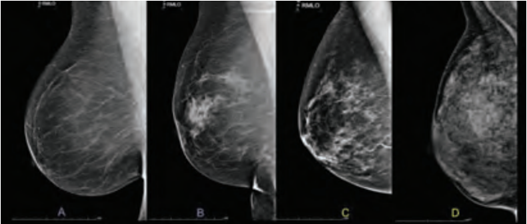Dense Breast Tissue
If you’ve been diagnosed with dense breasts, know that it’s normal and you’re not alone—in fact almost 40% of women have dense breast tissue.
All breasts are made up of fat and tissue but the ratio is different for every woman. Some have more fat, some have more tissue—and breasts that have more breast tissue than fat are considered dense.
When it comes to breast density, every woman falls into one of four categories:
- Almost entirely fatty breasts (A), which occurs in about 10% of women
- Dense tissue areas scattered through the breasts (B), which occurs in about 40% of women
- Evenly dense breasts (C), which occurs in about 40% of women
- Extremely dense breasts (D), which occurs in about 10% of women

While you probably won't experience any symptoms from your dense breasts, it does make detecting cancer more difficult. That's because, as shown above, dense breast tissue appears white on a mammogram, which often resembles or hides cancer.
Breast density can be affected by genetics, pregnancy, using estrogen hormone therapy, and even age — younger women’s breast tissue tends to be denser, while older women who have been through menopause tend to have less dense breasts.
3D mammography helps more easily identify lumps or masses in dense breast tissue. So if you have dense breasts, ask your doctor about using 3D mammography for your annual mammogram.